Top Email Marketing Trends for Success 2025 in 2025

Email marketing remains a cost-effective tool for engaging clients and attracting new leads. It’s so effective that 62% of B2B and B2C marketers have increased their budgets in the past year.
As we move into 2025, emerging technologies are transforming how marketers leverage email, while changes in privacy and security standards are prompting a reassessment of success metrics. In this article, we will show you the most potential marketing trends to apply in your strategies from 2025-2026. Let’s check it!
11 Best Email Marketing Trends in 2025- 2026
1. Email Marketing Using AI
Artificial Intelligence (AI) has rapidly gained momentum over the past year, significantly impacting email marketing. Its growing popularity among marketers is due to its ability to personalize content, craft effective messaging, and intelligently segment audiences.
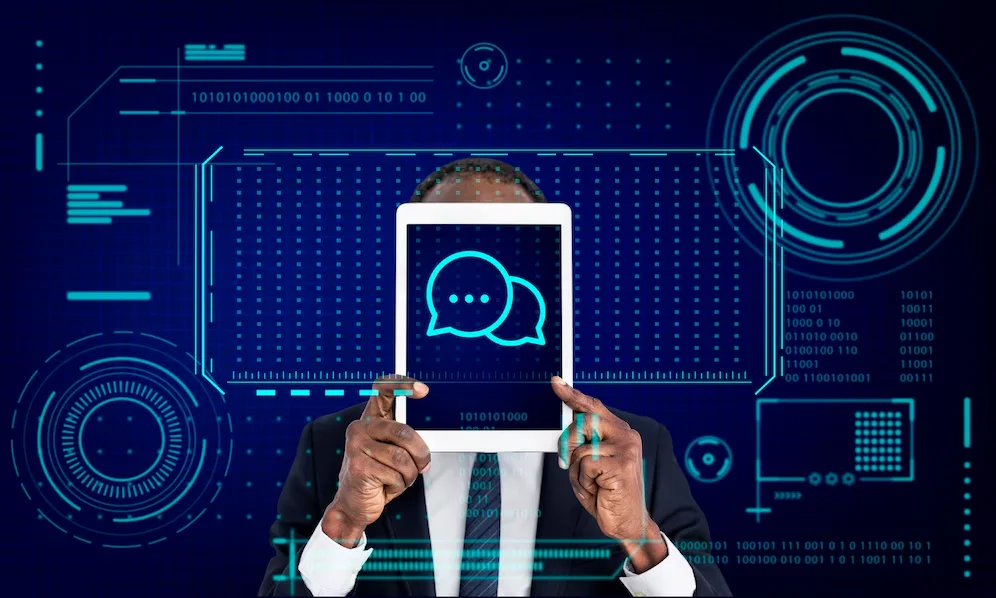
Marketers are leveraging AI to:
- Tailor content deeply based on user behavior, preferences, and purchase history
- Optimize send times using AI-driven algorithms
- Enhance subject lines, body text, and CTAs for higher engagement
- Automate content creation in line with brand voice and audience preferences
- Analyze email deliverability and spam scores to improve inbox placement
- Predict unsubscribes and initiate reactivation campaigns proactively
AI is primed to revolutionize the industry in the future of email marketing. As AI continues to evolve, its applications in this field will also expand.
2. Interactive Emails
Interactive elements like quizzes, polls, sliders, and interactive infographics are boosting email engagement and allowing marketers to collect real-time feedback directly from their campaigns. These features not only improve the user experience but also provide you with valuable insights into customer preferences.
To ensure success, interactive emails need to be tested and optimized for various devices. Additionally, engagement strategies should be continuously refined to align with the brand or campaign goals. Here is an example:
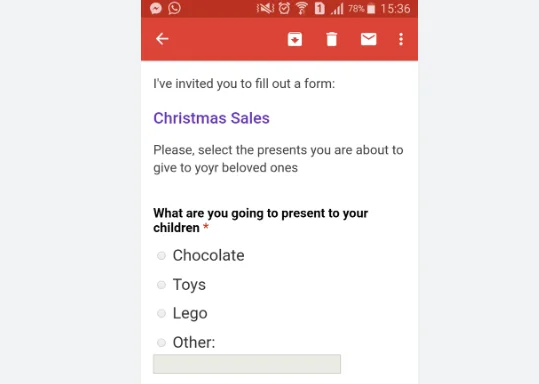
3. Email with Attractive Videos
Why are videos and visuals becoming increasingly vital in email marketing? It’s straightforward: they grab attention in ways that text alone cannot. In an inbox crowded with words, a video or vibrant visual stands out, providing a more dynamic and engaging experience.
HubSpot’s State of Marketing 2023 report underscores this trend, noting that video has been the most popular media format for the fourth year in a row. Videos aren’t just popular; they’re also highly effective, with 25% of respondents identifying them as delivering the highest ROI.
Incorporating interactive elements like GIFs, image carousels, and videos not only makes emails more engaging but also encourages subscribers to spend more time with your content. Strategically placing these visuals can break up text and emphasize key messages or offers. Additionally, experimenting with various types of visuals, such as infographics or animated illustrations, can help convey information in a more engaging and memorable way, ensuring your readers understand and retain your message.
4. Gamification Email
Gamification in email marketing is like a secret weapon for increasing customer engagement and boosting revenue. Gamified campaigns can be highly effective. For example, Kop & Kande gained 15,000 new email subscribers and achieved a 17.85% increase in revenue through their daily Christmas Calendar emails.

Source: Hustlermarketing
The language-learning app Duolingo has also found success with gamified emails, incorporating mini-quizzes and progress reports that keep users engaged and encourage regular app use.
Fitness tracker Fitbit has adopted this strategy as well. Their annual fitness achievements newsletter turns a year’s worth of workouts and steps into a fun, shareable recap, making each user’s fitness journey feel like an exciting adventure.
5. Dark Mode Email
Why is dark mode becoming so popular? It’s perfect for low-light environments, allowing users to check emails in bed or a dark room without being too bright or intrusive. It’s also believed to reduce blue light emissions, which can disrupt sleep patterns. Additionally, dark mode helps conserve battery life on mobile devices and offers a more comfortable viewing experience for those with light sensitivity or visual impairments.
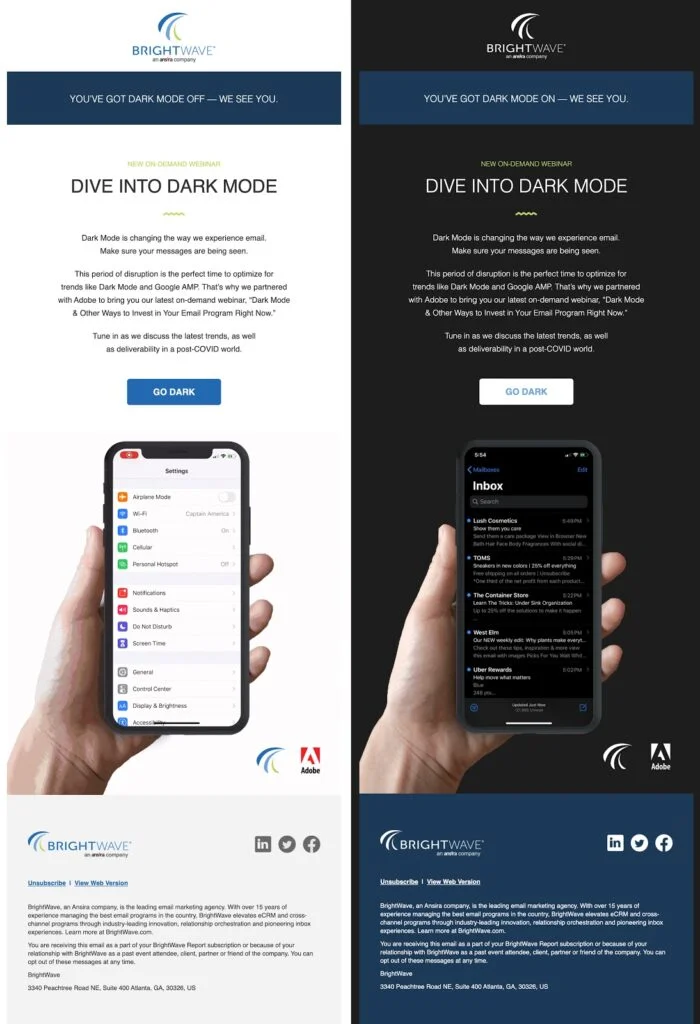
Source: Litmus
In email design, adopting dark mode requires understanding how it impacts the appearance of your emails. While the technical aspects of rendering emails in no-change, inverted color, or custom dark modes are crucial, the broader trend for 2025 and beyond is the emphasis on adaptable and responsive email design. This means creating content that looks appealing and functions well in both light and dark modes. As email design continues to evolve, dark mode is expected to gain even more traction.
However, designing for dark mode comes with challenges. For instance, image-only emails might not work well in dark mode, as fixed background colors can clash with the dark interface. This necessitates a careful selection of colors and images that work seamlessly in both light and dark modes.
6. BIMI Application
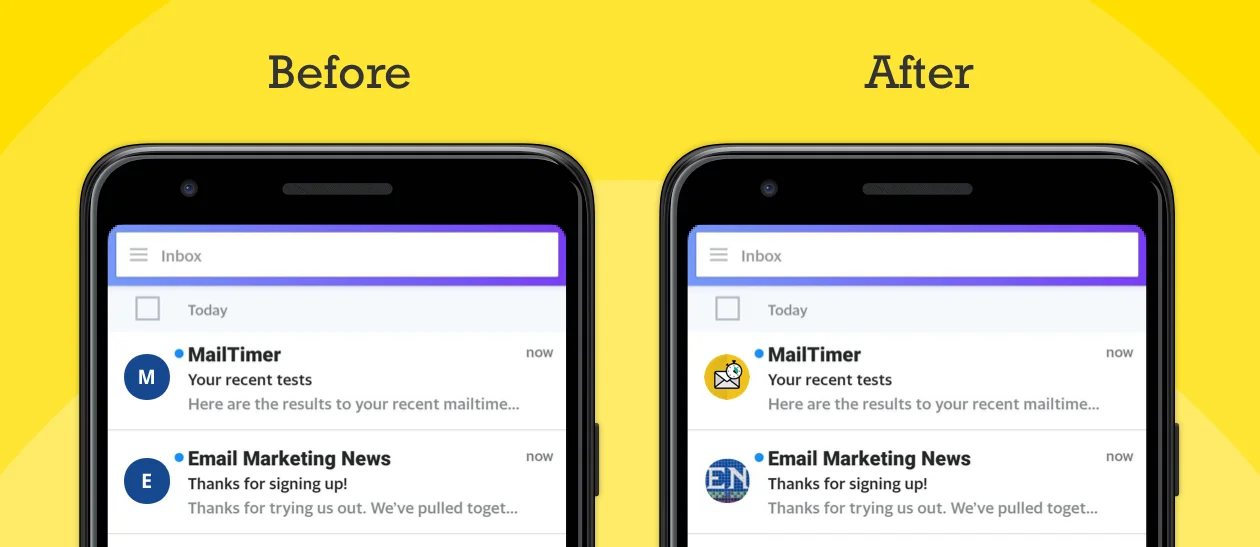
BIMI, which stands for “Brand Indicators for Message Identification,” is a relatively new concept in email marketing for 2025. This email authentication protocol allows companies to display their brand logo next to their email messages in customers’ inboxes. It’s currently supported by Google, AOL Mail, and Fastmail.
The main purpose of BIMI is to enhance brand trust and visibility in the recipient’s inbox, helping to differentiate legitimate emails from potential phishing or spoofing attempts. By showcasing a recognizable brand logo alongside the email, recipients are more likely to identify the message as genuine.
Beyond building trust and credibility, marketers are using BIMI to increase brand recognition, boost email open and engagement rates through greater familiarity and trust, and stand out from competitors who haven’t yet adopted this feature.
7. User-Generated Content (UGC)
Seventy-two percent of consumers find user-generated content (UGC), such as reviews and testimonials, more credible than a brand’s own claims. To enhance credibility and trust, marketers are incorporating customer-created reviews, photos, and videos into their marketing emails.
Brands are inviting customers to share their stories and tag the brand on social media, highlighting real-life applications and results. While this strategy is most common in B2C marketing, B2B marketers are also increasingly leveraging UGC through social media channels, customer video reviews, community forums, and collaborations with other businesses.
8. First-Party Data Shifting
With browsers phasing out third-party cookies, marketers are being pushed to adopt cookieless attribution methods for collecting marketing data. As a result, first-party data has become the cornerstone of many email marketing strategies.
First-party data, gathered directly from email subscribers, is not only more accurate than third-party data but also provides a wealth of insights. Marketers can collect this data through email sign-up forms, newsletters, and surveys.
Transactional emails, like purchase confirmations and appointment reminders, can also include surveys or feedback requests, enriching customer profiles and enabling more personalized email marketing strategies. Over time, marketers can build a rich database of customer information, enabling them to tailor their campaigns more effectively.
9. CTR Metric Focus
Open rates were once a key metric for evaluating email campaign performance. However, privacy changes, such as the removal of cookies, are causing marketers to rethink their reliance on this metric. For instance, Apple’s new privacy settings prevent marketers from tracking when, where, or on which device an email is opened.
Open rates can also be misleading due to technical factors; an email is considered “opened” if the email client loads the images, but this doesn’t necessarily mean the recipient actually read the email.
Clicks, on the other hand, indicate a more intentional action, reflecting genuine interest or curiosity. Click-through rates (CTR) calculate how many recipients clicked on a link within the email, showing a higher level of engagement. A click suggests the content was compelling enough to drive an action.
Additionally, clicks are closer to conversions than opens. When someone clicks on a link, they are usually taken to a landing page or product page, increasing their likelihood of buying or completing another conversion goal. Open rates don’t offer the same insight into the conversion process.
10. Creative Email Designs
The trend toward innovative email design goes beyond aesthetics; it’s a strategic effort to capture readers’ attention in a crowded inbox. Brands are using bold colors, interactive elements, and sleek layouts to make their emails visually appealing and engaging. Well-designed emails serve as a key part of the messaging, similar to a well-tailored suit, conveying much before any text is read.
These designs guide the reader’s journey, using typography and imagery to narrate the content rather than just decorate it. The goal is to create an immersive experience that captivates from the subject line to the call to action (CTA), transforming simple messages into compelling stories.
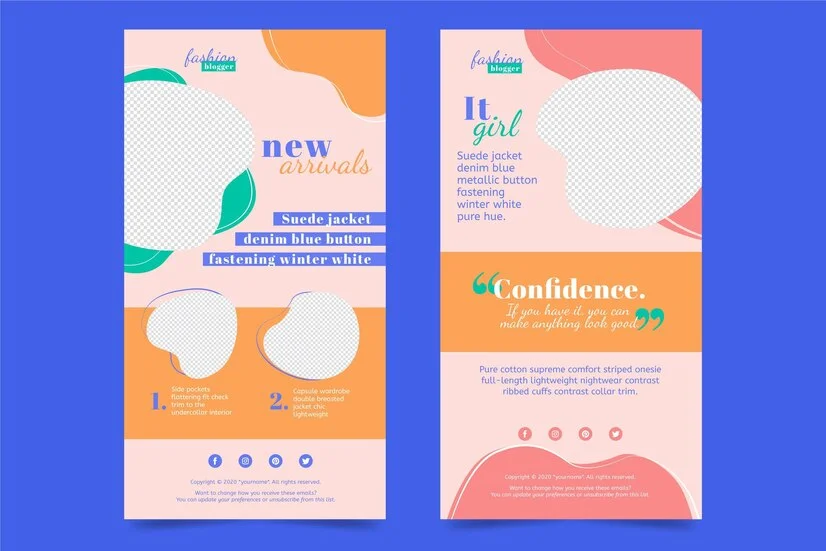
This design-driven approach recognizes that an email’s appearance significantly influences its effectiveness. Brands that excel in this area not only stand out but also build stronger connections with their audience, driving higher engagement and conversions. Ultimately, innovative email designs aim to enchant and motivate action, demonstrating that in email marketing, aesthetics play a crucial role.
11. Email Prioritizing on Mobile Devices
With mobile traffic dominating the market in November 2023 at 63.64%, it’s evident that most of your audience is engaging with content on their mobile devices. This shift is even more significant among younger generations, with 91% of Americans aged 18 to 49 using smartphones for online shopping, according to the Pew Research Center. This data underscores the critical need to optimize email marketing for mobile devices. As we move into 2025, making email campaigns mobile-friendly is essential to maximize reach and engagement in a mobile-centric world.
To ensure your emails are mobile-friendly, consider these key strategies:
-
Concise Copy: Keep your text brief and compelling. Use bullet points instead of long paragraphs. Remember, you have just 25-30 characters to make an impact with your subject line on mobile devices.
-
Mobile-Friendly Design: Not all phones load images by default, so design your emails to be effective even without visuals. Ensure your message is clear and impactful without relying on images.
-
CTA Placement and Size: Position your CTAs in the center of the screen for easy access. Make them large enough for easy tapping, as fingers are less precise than mouse pointers.
-
Spacing and Navigation: Space out links and buttons to avoid clusters, making it easier for readers to tap the correct link without frustration.
Tips to apply the latest email marketing trends to your strategies
Maintaining a competitive edge in email marketing requires continuous adaptation to evolving trends. Here are some key strategies to consider:
Implement Personalization for every email
Personalization and segmentation are crucial for effective email marketing. By collecting data on subscribers and dividing them into targeted groups, marketers can create highly relevant and engaging content. This tailored approach not only increases open rates and click-through rates but also improves overall campaign performance and ROI. Techniques like personalized product recommendations, triggered campaigns, and time-based emails can be employed to effectively reach and engage specific audience segments.
Leverage AI and Automation
Leveraging AI and automation in email marketing can significantly enhance efficiency and effectiveness. AI-powered tools can analyze bug amounts of data to identify patterns and preferences, enabling marketers to send highly personalized and targeted campaigns. Automation streamlines repetitive tasks, freeing up time for more strategic activities. By automating processes like sending welcome emails, abandoned cart reminders, and triggered campaigns, marketers can ensure timely and consistent communication while maintaining a high level of personalization.
Pay Attention to Email Deliverability
Email deliverability is indispensable for the success of any email marketing campaign. It refers to the ability of your marketing emails to reach your subscribers’ inboxes without being filtered as spam. Poor deliverability can significantly impact your campaign’s effectiveness, leading to missed opportunities and decreased ROI.
To ensure high deliverability, it’s essential to:
- Authenticate your emails: Use authentication protocols like SPF, DKIM, and DMARC to verify the sender’s identity and prevent spoofing.
- Avoid spammy practices: Refrain from using excessive exclamation marks, all-caps text, or excessive links in your emails.
- Monitor your sender’s reputation: Keep track of your sender’s reputation and take steps to improve it if necessary.
Try New Formats
To stay ahead in email marketing, it’s essential to experiment with new formats. AMP for Email allows for the creation of interactive elements like carousels, forms, and accordions, enhancing user engagement. Additionally, shifting towards a more conversational and engaging tone in email newsletters can foster a stronger connection with subscribers, making your content more enjoyable to read. By embracing these innovative approaches, you can differentiate your campaigns and drive better results.
Conclusion
In summary, email marketing should prioritize creating a cohesive, customer-centric experience in an era of data overload.
Brands can leverage AI, innovative design, and modern technologies to keep emails fresh and personalized. However, it’s equally important to ensure that email content is engaging, interactive, relevant, and respects customer data privacy.





![Top 20+ Must-have Shopify Apps for 2025 [Free & Paid] - Mageplaza](https://cdn2.mageplaza.com/media/blog/must-have-shopify-apps/top-must-have-shopify-apps.png)
![[2025 Updates] Top 10+ Upsell Apps for Shopify - Mageplaza](https://cdn2.mageplaza.com/media/blog/best-upsell-shopify-app/cover.png)